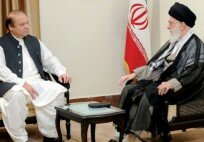Counterpoint
By Hassan Belal Zaidi –
How quotas for women in legislatures don’t accomplish what they should
Representation is the key to any democratic system of government. The idea that a small number of individuals can, collectively, embody the ‘will of the people’ and represent their constituents in the highest halls of decision-making is rooted in the assumption that those who reach these halls are, in fact, chosen by a much larger number of people in the first place. But when it comes to minorities, whether they are defined on gender, religious or ethnic grounds, positive discrimination and affirmative action is now applied. This means that in order to counter an inherent bias against these normally ‘under-represented groups’, steps are taken to inject such groups into the representative assemblies and legislatures, so their composition becomes more representative of society at large.
In theory, at least. Quotas, or the allocation of specific seats for women, although technically in place since the very first Constituent Assembly of Pakistan, proved to be quite ineffective in mainstreaming women’s issues when it came to policymaking at the highest level. From 1947 to 1973, the quota for women in parliament fluctuated between two to five percent. This meant that no more than six to eight women were present in the assemblies at any given time in this period. When the assembly was formed following the 1977 elections, it featured the first woman deputy speaker in the country’s history and included 11 members on reserved seats. This was still nowhere near proportionate to the percentage of women in the population, but it was considered a step in the right direction.
This number went up to 20 in the next elections of 1985. Things did not change much after that, until the advent of General Pervez Musharraf, who increased the number of reserved seats for women in the National Assembly to nearly 60 and Senate seats to 17. It was these years that also saw the rise of women in constituency-based politics and in the elections of 2002, 13 women won general seats. The trend has been consistent and we currently have 16 woman legislators on general seats, alongside the 60 on reserved seats.
While the numbers may sound impressive, the effectiveness of their presence is a large question mark. Today, while Pakistan can boast an impressive number of women as legislators and in other key decision-making positions, it is obvious that this does not directly correlate to the betterment of the status of women in society. Granted, that social change and behavioral changes do not occur overnight, but still, there should be a better way to promote the mainstreaming of women into politics. A way that allows politicians to be groomed, like a handful have been before them. Women such as Fatima Jinnah and Benazir Bhutto.
Before arguing against the permanent adoption of a quota for women legislators in the federal and provincial assemblies, an important clarification must be made: the principle of women’s representation at the highest levels is not being debated. Indeed, the case that is being made envisions a greater role for women in government without the ‘handicap’ of reserved seats.
Disingenuous Handicap
While the mechanism for the selection of women members on reserved seats is explained quite succinctly elsewhere in this publication, it is the consequences of that methodology that contribute to the disdain with which most such members are treated in the House. Many parliamentarians have accused their male counterparts of treating them as “half members” and insisting that the development funds allocated to them be smaller than those allotted to members who have come to the House via general seats. This has created bad blood between women members and their male counterparts too many times, especially in the Punjab and Sindh assemblies. And even in the federal legislature, members such as Kashmala Tariq have constantly complained of discriminatory treatment.
If one deconstructs the role of women parliamentarians in pushing for legislation such as the Acid Control and Acid Prevention Act 2011, Sexual Harassment at Work Place Act 2010, Prevention of Anti-Women Practices Act 2011 and Women in Distress and Detention Act 2011, it is painfully obvious that these were heavily watered down by the alliance between the mullah lobby and the right-wingers in the parliament. Most of the opponents of these bills are quite guilty of not taking the women seriously. But the irony is that if the requisite pressure is applied, elected women members from the ruling coalition can exert considerable influence on these nay-sayers. As with all other political maneuverings, it will take a great deal of tact and guile to get such things through the parliament. But it is indeed sad that nearly none of the women in the Assembly, not even Sherry Rehman, fully grasp this aspect. Which is why the Domestic Violence Bill is still just a bill, despite having first been tabled in 2009.
Leadership Gap
An irony of the quota system is that nearly all women selected by political parties to represent them in the parliament are associated with one political dynasty or the other. Unlike the Senate, where members are chosen in a relatively meritocratic manner, there is no such convention for those chosen to represent parties in the parliament. This yields quite a motley mix of members, most of whom have no political constituency or background per se.
The exceptions that prove the rule, such as Sherry Rehman and Farahnaz Isphani, are there in almost every parliament and have actually made substantial contributions with regards to women-specific legislation in the past. However, all of these ‘heavyweights’ can just as easily win on ‘safe seats’ in a constituency of their choosing.
The prime example that automatically springs to mind is that of the late great Benazir Bhutto, who rose to political prominence not because she was a woman, but because she was a Bhutto. She too had to learn the ropes of government and had her share of good and bad decisions as well. But the one thing she succeeded in doing was to demonstrate how effectively a woman, if she is politically groomed in the manner that Bhutto was (a political education at the side of Zulfikar Ali Bhutto is as good as it gets), can lead the country through the best of times as well as the worst of times. In her case, after a certain point in time, it was never about her being a woman.
This is especially true of her time in exile in the Nawaz-Musharraf years. Her influence over the political landscape of Pakistan – while in exile – is matched only by Nawaz Sharif and now to a certain extent, Altaf Hussain. Granted that Benazir was, as her name suggests, ‘matchless’, but that does not mean that we cannot or will not have more leaders in her image ever again.
A Representative Problem
There is a stark difference between dynastic and feudal/hereditary politics. While Benazir Bhutto was an ideal example of a well-groomed leader of national vision, examples abound of women who, while hailing from influential and politically active households, are merely pushed into the limelight to replace a disqualified or deceased relative. Such women are also from similarly privileged backgrounds and quite disconnected from constituency problems and politics.
Many, even our current Foreign Minister Hina Rabbani Khar, have had to make the transition into politics because the principal political player in the family, her father in this case, was no longer eligible for a seat. While Ms Khar came into the House on a general seat this time around and has managed to bag a prize portfolio in the Cabinet, it must be said that even she does not represent the political maturity and prudence demonstrated by other ‘political powerhouses’, such as Samina Khalid Ghurki or Tehmina Daultana or Faryal Talpur.
Nuisance Value
Then we come to the so-called “centerpieces” of the parliamentary circus. These members have been relegated to being distractions and are employed by their parties when they need to throw the opposition (or the government, as the case may be) off their track. MPAs Seemal Kamran and Samina Khawar Hayat of Punjab and MPAs Shazia Marri and Marvi Rashidi of Sindh have brought much notoriety to both legislatures.
The former are known House trolls, who are quite adept at breaking lotas on-air and lampooning their opponents on the floor and outside the House. Law Minister Rana Sanaullah and Speaker Rana Iqbal are often at a loss whenever both decide to go on a rampage, unable to reprimand or respond as effectively to the women as they may to the men. Ask poor Chaudhry Ghafoor, former Prisons Minister and class clown for the PML(N). The gaffe prone legislator was such a favorite target of both women that he has had to leave the House on many occasions after facing constant badgering.
Marri and Marvi have also been in the news, for fighting over petty things such as the amount of make-up one wears and the kind of English language skills the other has, rather than concentrating on House business. Even here, the honourable Nisar Khuhro has done his best to keep the two out of trouble, but they are able to raise their voices and defy the speaker with great ease.
What is also unfortunate in such cases is the media’s treatment of such women. On the screens of Geo, Express, ARY, SAMAA and the like, such legislators are reduced to mere characters, whether it be through ‘creative reporting’ (also referred to in industry circles as ‘Jhankar Studio Packaging’) or on talk shows. The archetype of the woman who is interesting not because of her contribution to the business of the House, but rather because of her ability to distract from it, is what is most damaging. Whether it be playing ‘lota football’ outside assembly doors or the badgering of fellow members or the parade of the latest lawn prints, such women only serve to further the stereotypes and do not contribute towards the greater goal of bringing women into the mainstream of political discourse and policymaking.
There are also those, such as YouTube heroine and emotional MQM representative Fauzia Ejaz Khan, who shot to fame after a charged outburst at fellow members and Deputy Speaker Faisal Kundi for not debating “the real issues”. Her tirade is now legendary, thanks to the social media. While her credentials as an MNA are satisfactory (given the keen interest the MQM takes in the problems of women), her two cents in each session she has had a chance to speak in have generally been incendiary yet rhetorical. With these ‘proactive’ legislators, the question always is of initiatives and the introduction of private members’ legislation. Most are found wanting on both counts and have very bad truancy records.
Playing the Game
It is obvious that having 70-odd women in a ‘boys club’ parliament is not having an effect. The primary alternative, then, would be to abolish the quotas and have women contest elections on the same platforms as their male counterparts. This, for obvious reasons, won’t work in isolation. But what is certain is the need for Pakistan to increase the amount of political power and sway that women hold. This can only be accomplished if women are represented in the assemblies in proportion to their numbers in the overall populations. While this will not be achieved under the status quo, ever, and the perpetuation of the quota system will merely ingrain the dichotomy further, unique measures, conducive to the social and religious sensitivities that prevail here, can help. We must explore the possibility of having a separate electorate for women, along the lines adopted by many countries that gained independence during the latter half of the 20th century. But it feels like there hasn’t been a strong enough effort on the part of the women lawmakers themselves to push for these policies. This, however, can be put down to the inherently undemocratic structure of political parties that do not prioritize such issues within the agenda of legislation. While the ruling PPP has accomplished a lot, the cause is not yet exhausted and there is still a long way to go before women can actually become representative lawmakers, rather than just names on a list.
What is missing from the status quo is a genuine effort to allow women to become a political power. Political parties need to demonstrate a greater commitment towards promoting women’s involvement in the political sphere. As military interludes have damaged democracy in general, so too have they been detrimental to the development and grooming of women leaders.
Local government systems which included the provision for women councilors and female Nazims and Naib Nazims were a step in the right direction, but again, exploited by the parties in power for their own benefit. If women are given the right to vote in a parallel system, whereby they can cast their ballots exclusively for women leaders rather than voting along familial party lines, it would be a great step up for their cause.
The writer is a former journalist who works for the development sector.































































































